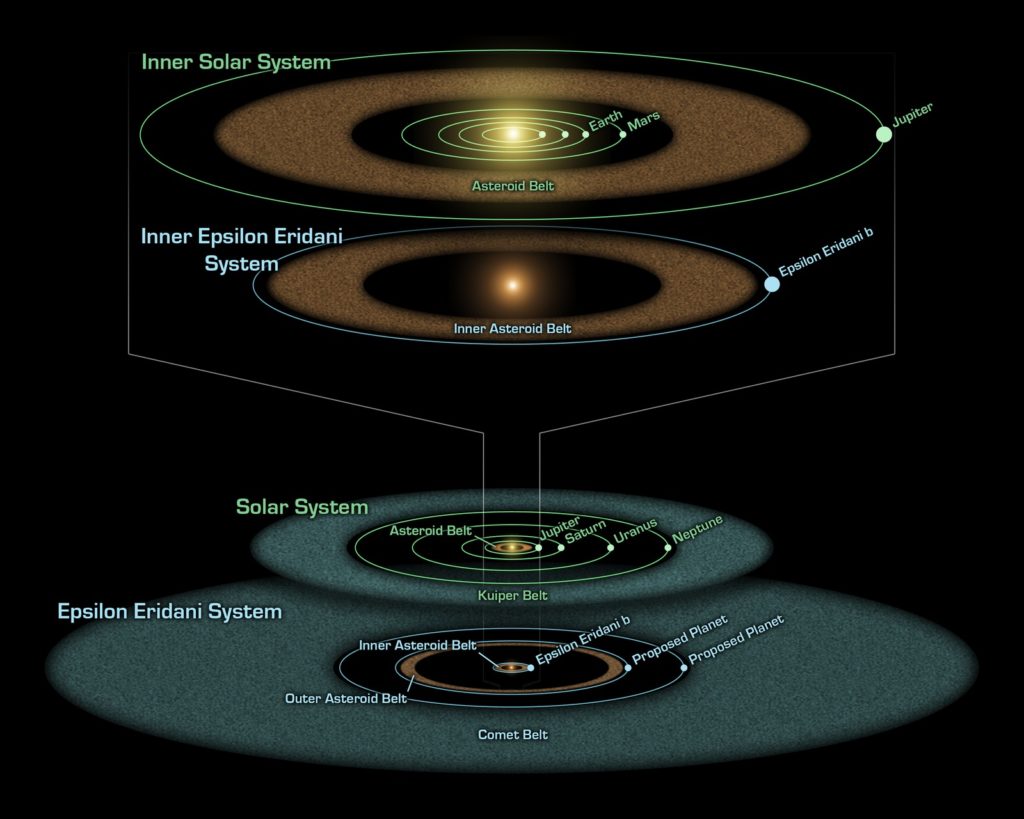Although known to early star gazers, Epsilon Eridani does not figure heavily in myth. Claudius Ptolemy was the first astronomer to pay this star any sustained attention, cataloguing it in his famous 2nd-century Almagest. Indeed, it was Ptolemy that named the constellation Eridanus, after the ancient Greek word for ‘river’ (Ποταμού).
Epsilon Eridani famously entered public imagination in 1960, when Frank Drake pointed a radio telescope towards it and nearby Tau Ceti. No one said ‘hi’.
At less than a billion years old, Epsilon Eridani (ε Eridani), is a quarter the age of our sun. While the sun is a G2 spectral type yellow dwarf, ε Eridani is a K-type orange-red dwarf. It’s the third closest star visible to the naked eye and the tenth closest to the sun.
Our sun and Epsilon Eridani have many similarities and also many differences. Their temperatures are relatively similar, at 5000K for ε Eridani and 5700K for the sun. It’s also similar in size, with a radius about 3/4 that of our sun. But it’s much less luminous, and much more magnetic.
These similarities and differences, especially its youth, allow us to make inferences about the formation of our own solar system. In 2015, Massimo Marengo of Iowa State University flew onboard NASA’s Stratospheric Observatory for Infrared Astronomy (SOFIA). SOFIA is an infrared telescope with an effective diameter of 2.5m, mounted inside a Boeing 747.
For Marengo, SOFIA’s “unique ability of capturing infrared light in the dry stratospheric sky, is the closest we have to a time machine, revealing a glimpse of Earth’s ancient past by observing the present of a nearby young sun.”

Flying high
The stratosphere lies 11-50km above the Earth’s service, above the first layer of the atmosphere, the troposphere. The troposphere blocks infrared radiation. So by flying above it, astronomers can study objects which emit radiation in the infrared band of the electromagnetic spectrum. If you’ve been in a jet airliner, you’ve been in the stratosphere. (And if you like this article, my mood will be stratospheric.)
The SOFIA observatory entered service in 2010 and was decommissioned in 2022. During that time it made many contributions to the study of star and planetary formation, nebulae, even black holes. It also confirmed the existence of two asteroid belts, orbiting inside and outside of the already detected gas giant Epsilon Eridani b.
In 2014, the International Astronomical Union held a competition to give the star and the planet a more interesting name. Epsilon Eridani can also now be called Ran. The confirmed exoplanet has an even more enigmatic moniker: AEgis.
The two asteroid belts may be rocky debris in the process of planet formation. Or, as is assumed with our asteroid belt, the nearby gas giant, AEgis, may have torn apart any aspiring planetoids.
Detection
Physicists detected Epsilon Eridani b using the radial velocity method, which measures discrepancies (or wobbles) in a star’s motion through the galaxy. AEgis, like Jupiter, is a gas giant. It orbits ε Eridani at 3.5AU, or 3.5 times the Earth’s distance from the sun. It’s orbital period is 7.4 years. Analysis of the asteroid belts has led scientists to postulate the existence of two other planets, although none lie within the habitable zone (0.5-1AU).

Like our own system, Epsilon Eridani has its own Kuiper Belt, a ring of cometary material patrolling the outer limits.
The proximity of ε Eridani and its many interesting features mean it will remain closely studied. As Marengo notes: “This star hosts a planetary system currently undergoing the same cataclysmic processes that happened to the solar system in its youth.”
But life might struggle around ε Eridani, at least for now. As a result of its fast rotation period the star generates a strong magnetic field, and this may lead to heightened solar activity not conducive to good internet connections and civilised life.
Epsilon Eridani fast facts:
Distance: 10.5 light years (3.2 parsecs)
Absolute magnitude: 6.19
Apparent magnitude: 3.73
Spectral type: K2 V
Rotation period: 11.2 days
Surface temperature: ~5000°K (4727°C)
In Tales from the Orion Arm, an inner rocky planet orbits Epsilon Eridani. It is here, on Epicurus, that the rich retire, and tourists play golf and acquire artificial tans.
In space opera, ε Eridani features in Star Trek and Babylon 5. It’s also in the Halo video game franchise and is heavily colonised in the Elite Dangerous MMOG. It appears in several Isaac Asimov novels such as the Foundation series.
